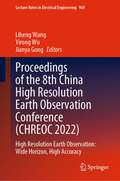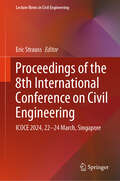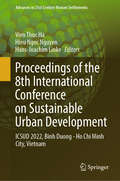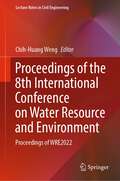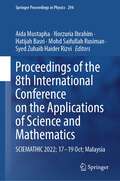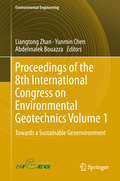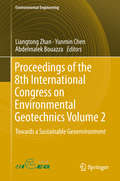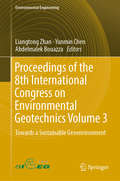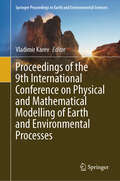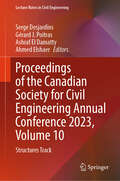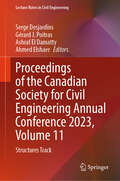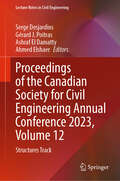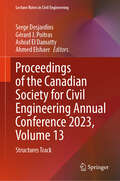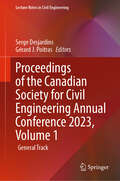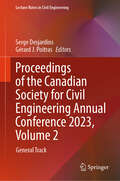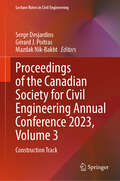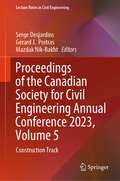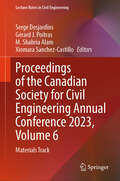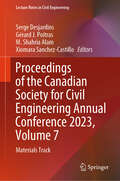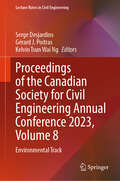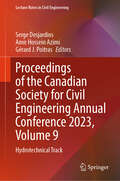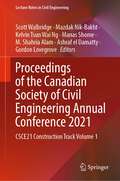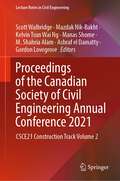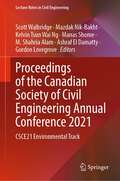- Table View
- List View
Proceedings of the 8th China High Resolution Earth Observation Conference: High Resolution Earth Observation: Wide Horizon, High Accuracy (Lecture Notes in Electrical Engineering #969)
by Liheng Wang Yirong Wu Jianya GongThis proceedings has four thematic parts: advanced aerospace manufacturing technology, near space system and application technology, accurate perception technology of the earth, and collaborative fusion application technology. The CHREOCs (China High-resolution Earth Observation Conference) focus on the popular topics including military-civilian integration, the One Belt and One Road project, the transformation of scientific research achievements, and it also discusses the new ideas, new technologies, new methods, and new developments. The CHREOCs have effectively promoted high-level institutional mechanisms, technological innovation, and industrial upgrading in the high-resolution earth observation area, and arouse the influence of the national-sponsored major project. All papers in this proceeding are from the 8th CHREOC, and most authors are the researchers and experts participating the state major project CHEOS. The papers are the extraction of research results and reflect the technique level and research direction of the field high-resolution earth observation. All articles have gone through the scientific and strict reviews for several rounds by the experts from the related fields, and therefore reflect the research level and technology innovation of the high-resolution field earth observation. It will be an informative and valuable reference for both academic research and engineering practice. The year 2022 is the final year of high-resolution special projects. After more than ten years of construction, the task of high-resolution special projects has been basically completed, the core technology has been comprehensively breakthrough, and the typical achievements have been rapidly transformed, providing strong support for national security, national defense construction and national economic development.
Proceedings of the 8th International Conference on Civil Engineering: ICOCE 2024, 22–24 March, Singapore (Lecture Notes in Civil Engineering #539)
by Eric StraussThis book consists of the most recent group of peer-reviewed research papers presented at the 8th International Conference on Civil Engineering, ICOCE 2024 held in Singapore from March 22 to 24. Important issues addressed in the book show the emerging relationships between technology and the built environment. Engineering solutions are treated from a global perspective. Highlighted fields of inquiry include hazard mitigation, materials management, transportation, water resources, and public policy. The authors outline solutions to physical, environmental, and social problems in many different contexts. This book contains refereed articles authored by a wide variety of international researchers and practitioners from many perspectives discussing current research solutions from a global perspective to problems in civil and environmental engineering. Examples that cover construction management, water issues, public safety, and urban development are emphasized. The chapters contain a wide variety of applications that appeal to readers with varying levels of knowledge and interest in the important issues relevant to international engineering.
Proceedings of the 8th International Conference on Sustainable Urban Development: ICSUD 2022, Binh Duong - Ho Chi Minh City, Vietnam (Advances in 21st Century Human Settlements)
by Hans-Joachim Linke Vien Thuc Ha Hieu Ngoc NguyenThis book includes peer-reviewed articles from the 8th International Conference on Sustainable Urban Development (ICSUD 2022), held at the Vietnamese-German University (VGU) in Vietnam. The theme of the conference is “innovative and inclusive growth models for sustainable urban development”. Articles in this book present major issues that cities and regions around the world are facing these days to adapt to new, unexpected, and profound challenges.Over past few years, the world has been observing meaningful reactions to crises. From the pandemic to war, energy, and food shortages, there are always opportunities for innovations. Some firms still thrived in the city lock-down; some groups stayed healthier with less income; and certain municipalities consumed less resources to attain higher outcomes. However, the rise of digital economy, the importance of proximity or near-shore supply chain, or the new contribution of different communities at different levels are generalized asnew growth models for changes.
Proceedings of the 8th International Conference on Water Resource and Environment: Proceedings of WRE2022 (Lecture Notes in Civil Engineering #341)
by Chih-Huang WengThis book presents select proceedings of the 8th International Conference on Water Resource and Environment (WRE 2022) which is held in Xi’an, China, November 1-4, 2022. The book covers a wide range of topics, including Hydraulics, Hydrology and Water Resources Engineering, Environmental Engineering and Sustainability, Indoor Environments, Risk Analysis, Safety and Security, Ocean and Offshore Engineering; Ships and Floating Structures, Coastal Engineering. It will be useful for researchers and engineers working in water and environment related fields.
Proceedings of the 8th International Conference on the Applications of Science and Mathematics: SCIEMATHIC 2022; 17—19 Oct; Malaysia (Springer Proceedings in Physics #294)
by Syed Zuhaib Haider Rizvi Aida Mustapha Norzuria Ibrahim Hatijah Basri Mohd Saifullah RusimanThis book presents peer-reviewed articles and recent advances on the potential applications of Science and Mathematics for future technologies, from the 8th International Conference on the Applications of Science and Mathematics (SCIEMATHIC 2022), held in Malaysia. It provides an insight about the leading trends in sustainable Science and Technology. Topics included in this proceedings are in the areas of Mathematics and Statistics, including Natural Science, Engineering and Artificial Intelligence.
Proceedings of the 8th International Congress on Environmental Geotechnics Volume 1: Towards a Sustainable Geoenvironment (Environmental Science and Engineering)
by Yunmin Chen Liangtong Zhan Abdelmalek BouazzaThis book gathers selected papers presented at the 8th International Congress on Environmental Geotechnics (ICEG), held on October 28 - November 1, 2018 in Hangzhou, China. The theme of the congress is “Towards a Sustainable Geoenvironment”, which means meeting the needs of the present generation without compromising the ability of future generations to meet their own needs. Under this theme, the congress covers a broad range of topics and provides an excellent opportunity for academics, engineers, scientists, government officials, regulators, and planners to present, discuss and exchange notes on the latest advances and developments in the research and application of environmental geotechnics.
Proceedings of the 8th International Congress on Environmental Geotechnics Volume 2: Towards a Sustainable Geoenvironment (Environmental Science and Engineering)
by Yunmin Chen Liangtong Zhan Abdelmalek BouazzaThis is the third volume of the proceedings of the 8th International Congress on Environmental Geotechnics (ICEG 2018), held on October 28 - November 1, 2018 in Hangzhou, China. The theme of the congress is “Towards a Sustainable Geoenvironment”, which means meeting the needs of the present generation without compromising the ability of future generations to meet their own needs. Under this theme, the congress covers a broad range of topics and provides an excellent opportunity for academics, engineers, scientists, government officials, regulators, and planners to present, discuss and exchange notes on the latest advances and developments in the research and application of environmental geotechnics.
Proceedings of the 8th International Congress on Environmental Geotechnics Volume 3: Towards a Sustainable Geoenvironment (Environmental Science and Engineering)
by Yunmin Chen Liangtong Zhan Abdelmalek BouazzaThis book gathers selected papers presented at the 8th International Congress on Environmental Geotechnics (ICEG), held on October 28 - November 1, 2018 in Hangzhou, China. The theme of the congress is “Towards a Sustainable Geoenvironment”, which means meeting the needs of the present generation without compromising the ability of future generations to meet their own needs. Under this theme, the congress covers a broad range of topics and provides an excellent opportunity for academics, engineers, scientists, government officials, regulators, and planners to present, discuss and exchange notes on the latest advances and developments in the research and application of environmental geotechnics.
Proceedings of the 9th International Conference on Physical and Mathematical Modelling of Earth and Environmental Processes (Springer Proceedings in Earth and Environmental Sciences)
by Vladimir KarevThis book presents short papers of participants of the 9th International Scientific Conference-School for Young Scientists «Physical and Mathematical Modeling of Earth and Environment Processes. A special focus is given to the extraction of hydrocarbon resources, including from unconventional sources. An alternative to the use of hydrocarbons as a main source of energy on the Planet in the coming decades is unlikely to be found. At the same time, the resource base of hydrocarbons is quickly depleted, in particularly, large and accessible oil and gas fields. The shale oil and gas, Arctic hydrocarbon stocks, gas hydrates, coal bed methane, oil and gas from deep horizons can become new sources. "Deep oil" may be the most promising source of expanding the resource base of hydrocarbons according to many experts. New technologies are required to their development. Efficient low-cost technologies can be created on the basis of geomechanical approach, i.e., through the use of a huge elastic energy stored in the rock massif due to rock pressure. The creation of new breakthrough approaches to the development of hydrocarbon fields is very important in today's geopolitical conditions and requires the involvement of young minds and strength. International activities, including the youth scientific schools, can become an effective tool for exchange of information and the organizing of interdisciplinary research of processes in geo-environment. The book presents the new results of the experimental and theoretical modeling of deformation, fracture, and filtration processes in the rocks in connection to issues of creating scientific fundamentals for new hydrocarbon production technologies. The investigations of the dependence of well stability and permeability of rocks on the stress-strain state in conditions of deep horizons and high rock pressure are also represented.
Proceedings of the Canadian Society for Civil Engineering Annual Conference 2023, Volume 10: Structures Track (Lecture Notes in Civil Engineering #504)
by Ashraf El Damatty Serge Desjardins Gérard J. Poitras Ahmed ElshaerThis book comprises the proceedings of the Annual Conference of the Canadian Society for Civil Engineering 2023. The contents of this volume focus on the specialty track in structural engineering with topics on bridge design, FRP concrete structures, innovation in structural engineering, seismic analysis and design, wind load on structures, masonry structures, structural optimization, machine learning and AI in structural engineering, and wood and timber structures, among others. This volume will prove a valuable resource for researchers and professionals.
Proceedings of the Canadian Society for Civil Engineering Annual Conference 2023, Volume 11: Structures Track (Lecture Notes in Civil Engineering #505)
by Ashraf El Damatty Serge Desjardins Gérard J. Poitras Ahmed ElshaerThis book comprises the proceedings of the Annual Conference of the Canadian Society for Civil Engineering 2023. The contents of this volume focus on the specialty track in structural engineering with topics on bridge design, FRP concrete structures, innovation in structural engineering, seismic analysis and design, wind load on structures, masonry structures, structural optimization, machine learning and AI in structural engineering, and wood and timber structures, among others. This volume will prove a valuable resource for researchers and professionals.
Proceedings of the Canadian Society for Civil Engineering Annual Conference 2023, Volume 12: Structures Track (Lecture Notes in Civil Engineering #506)
by Ashraf El Damatty Serge Desjardins Gérard J. Poitras Ahmed ElshaerThis book comprises the proceedings of the Annual Conference of the Canadian Society for Civil Engineering 2023. The contents of this volume focus on the specialty track in structural engineering with topics on bridge design, FRP concrete structures, innovation in structural engineering, seismic analysis and design, wind load on structures, masonry structures, structural optimization, machine learning and AI in structural engineering, and wood and timber structures, among others. This volume will prove a valuable resource for researchers and professionals.
Proceedings of the Canadian Society for Civil Engineering Annual Conference 2023, Volume 13: Structures Track (Lecture Notes in Civil Engineering #507)
by Ashraf El Damatty Serge Desjardins Gérard J. Poitras Ahmed ElshaerThis book comprises the proceedings of the Annual Conference of the Canadian Society for Civil Engineering 2023. The contents of this volume focus on the specialty track in structural engineering with topics on bridge design, FRP concrete structures, innovation in structural engineering, seismic analysis and design, wind load on structures, masonry structures, structural optimization, machine learning and AI in structural engineering, and wood and timber structures, among others. This volume will prove a valuable resource for researchers and professionals.
Proceedings of the Canadian Society for Civil Engineering Annual Conference 2023, Volume 1: General Track (Lecture Notes in Civil Engineering #495)
by Serge Desjardins Gérard J. PoitrasThis book comprises the proceedings of the Annual Conference of the Canadian Society for Civil Engineering 2023. The contents of this volume focus on the general conference with topics on transportation, climate adaptability, sustainable design, green buildings, cold regions, and civil engineering education, among others. This volume will prove a valuable resource for researchers and professionals.
Proceedings of the Canadian Society for Civil Engineering Annual Conference 2023, Volume 2: General Track (Lecture Notes in Civil Engineering #496)
by Serge Desjardins Gérard J. PoitrasThis book comprises the proceedings of the Annual Conference of the Canadian Society for Civil Engineering 2023. The contents of this volume focus on the general conference with topics on transportation, climate adaptability, sustainable design, green buildings, cold regions, and civil engineering education, among others. This volume will prove a valuable resource for researchers and professionals.
Proceedings of the Canadian Society for Civil Engineering Annual Conference 2023, Volume 3: Construction Track (Lecture Notes in Civil Engineering #497)
by Mazdak Nik-Bakht Serge Desjardins Gérard J. PoitrasThis book comprises the proceedings of the Annual Conference of the Canadian Society for Civil Engineering 2023. The contents of this volume focus on the specialty track in construction with topics on modular and offsite construction, BIM, construction planning and project management, construction automation, AI and robotics in construction, sustainable construction, asset management, and construction safety, among others. This volume will prove a valuable resource for researchers and professionals.
Proceedings of the Canadian Society for Civil Engineering Annual Conference 2023, Volume 4: Construction Track (Lecture Notes in Civil Engineering #498)
by Mazdak Nik-Bakht Serge Desjardins Gérard J. PoitrasThis book comprises the proceedings of the Annual Conference of the Canadian Society for Civil Engineering 2023. The contents of this volume focus on the specialty track in construction with topics on modular and offsite construction, BIM, construction planning and project management, construction automation, AI and robotics in construction, sustainable construction, asset management, and construction safety, among others. This volume will prove a valuable resource for researchers and professionals.
Proceedings of the Canadian Society for Civil Engineering Annual Conference 2023, Volume 5: Construction Track (Lecture Notes in Civil Engineering #499)
by Mazdak Nik-Bakht Serge Desjardins Gérard J. PoitrasThis book comprises the proceedings of the Annual Conference of the Canadian Society for Civil Engineering 2023. The contents of this volume focus on the specialty track in construction with topics on modular and offsite construction, BIM, construction planning and project management, construction automation, AI and robotics in construction, sustainable construction, asset management, and construction safety, among others. This volume will prove a valuable resource for researchers and professionals.
Proceedings of the Canadian Society for Civil Engineering Annual Conference 2023, Volume 6: Materials Track (Lecture Notes in Civil Engineering #500)
by M. Shahria Alam Serge Desjardins Gérard J. Poitras Xiomara Sanchez-CastilloThis book comprises the proceedings of the Annual Conference of the Canadian Society for Civil Engineering 2023. The contents of this volume focus on the specialty track in materials with topics on recycled materials, concrete durability, geopolymers, alkali-activated and other alternative binders, fiber-reinforced and engineered cementitious composites, advanced composite materials, ultra-high-performance materials, and innovative and emerging materials, among others. This volume will prove a valuable resource for researchers and professionals.
Proceedings of the Canadian Society for Civil Engineering Annual Conference 2023, Volume 7: Materials Track (Lecture Notes in Civil Engineering #501)
by M. Shahria Alam Serge Desjardins Gérard J. Poitras Xiomara Sanchez-CastilloThis book comprises the proceedings of the Annual Conference of the Canadian Society for Civil Engineering 2023. The contents of this volume focus on the specialty track in materials with topics on recycled materials, concrete durability, geopolymers, alkali-activated and other alternative binders, fiber-reinforced and engineered cementitious composites, advanced composite materials, ultra-high-performance materials, and innovative and emerging materials, among others. This volume will prove a valuable resource for researchers and professionals.
Proceedings of the Canadian Society for Civil Engineering Annual Conference 2023, Volume 8: Environmental Track (Lecture Notes in Civil Engineering #502)
by Kelvin Tsun Wai Ng Serge Desjardins Gérard J. PoitrasThis book comprises the proceedings of the Annual Conference of the Canadian Society for Civil Engineering 2023. The contents of this volume focus on the specialty track in environmental engineering with topics on water and wastewater treatment, sustainability and climate change, remediation, and environmental hazards, among others. This volume will prove a valuable resource for researchers and professionals.
Proceedings of the Canadian Society for Civil Engineering Annual Conference 2023, Volume 9: Hydrotechnical Track (Lecture Notes in Civil Engineering #503)
by Serge Desjardins Gérard J. Poitras Amir Hossein AzimiThis book comprises the proceedings of the Annual Conference of the Canadian Society for Civil Engineering 2023. The contents of this volume focus on the specialty track in hydrotechnical engineering with topics on hydraulic structures, river engineering, water management, hydrology and machine learning, fluvial hydraulics, and sediment transport, among others. This volume will prove a valuable resource for researchers and professionals.
Proceedings of the Canadian Society of Civil Engineering Annual Conference 2021: CSCE21 Construction Track Volume 1 (Lecture Notes in Civil Engineering #251)
by Scott Walbridge Mazdak Nik-Bakht Kelvin Tsun Wai Ng Manas Shome M. Shahria Alam Ashraf El Damatty Gordon LovegroveThis book comprises the proceedings of the Annual Conference of the Canadian Society of Civil Engineering 2021. The contents of this volume focus on specialty conferences in construction, environmental, hydrotechnical, materials, structures, transportation engineering, etc. This volume will prove a valuable resource for those in academia and industry.
Proceedings of the Canadian Society of Civil Engineering Annual Conference 2021: CSCE21 Construction Track Volume 2 (Lecture Notes in Civil Engineering #247)
by Scott Walbridge Mazdak Nik-Bakht Kelvin Tsun Wai Ng Manas Shome M. Shahria Alam Ashraf El Damatty Gordon LovegroveThis book comprises the proceedings of the Annual Conference of the Canadian Society of Civil Engineering 2021. The contents of this volume focus on specialty conferences in construction, environmental, hydrotechnical, materials, structures, transportation engineering, etc. This volume will prove a valuable resource for those in academia and industry.
Proceedings of the Canadian Society of Civil Engineering Annual Conference 2021: CSCE21 Environmental Track (Lecture Notes in Civil Engineering #249)
by Scott Walbridge Mazdak Nik-Bakht Kelvin Tsun Wai Ng Manas Shome M. Shahria Alam Ashraf El Damatty Gordon LovegroveThis book comprises the proceedings of the Annual Conference of the Canadian Society of Civil Engineering 2021. The contents of this volume focus on specialty conferences in construction, environmental, hydrotechnical, materials, structures, transportation engineering, etc. This volume will prove a valuable resource for those in academia and industry.
